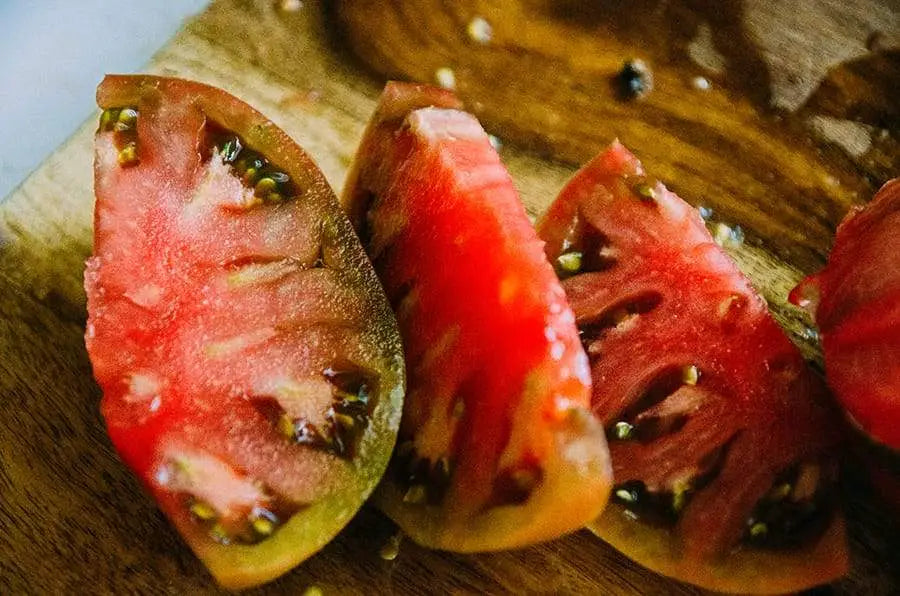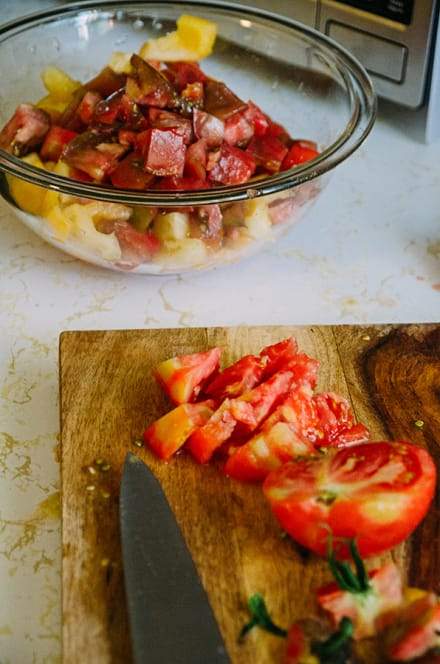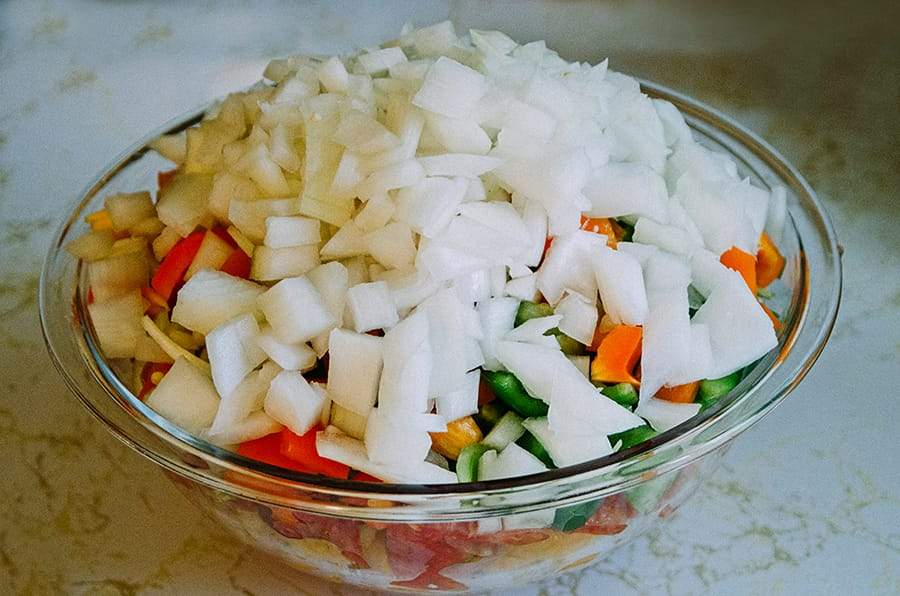One of the problems you may run into with growing your own food is simply having too much of it! You can only eat and give away so much, so an alternative is canning or preserving it! By canning your own fruits and veggies, you can save money and learn how to be almost completely self-reliant concerning food.
When you really break it down, canning is just food science. When you preserve food, you are basically freezing time. The simplest method of canning entails filling jars with acidic foods such as tomatoes, berries, fruit jams or jellies, or cucumbers in vinegar, covering them with lids and then boiling them in an open pot of water until the heat forms a seal under the lid. This method is called WATER BATH CANNING. Boiling the jars in a water bath forces the air out of the food and creates a vacuum in the acidic environment that prevents bacteria from forming. High acid foods preserved with this technique should keep for at least a year.
Water bath canning is a great place to start if you've never canned before, as it's very easy and affords you a variety of options such as jams and jellies, whole tomatoes and pickles. The process is fairly simple, just requiring a clean work environment and the ability to boil water. The lids, rings and jars themselves should all be boiled in a large pot prior to canning to ensure all bacteria has been eradicated. While boiling your jars, rings and lids, prepare the product that will be going into your jars according to your recipe. After product is ready to be canned, remove jars from boiling water, place them on a clean towel and carefully fill the jars with your product, leaving at least 1/2-1/4 inch space at the top.
Wipe the rims of the jars clean with a damp towel before screwing on the lid and ring. Return the full jars to the water you used to boil the jars initially, and once the water has returned to a boil, start the timer according to the recipe. You'll want to use a jar lifter to insert and remove your jars into and from the boiling water, as the jars must remain upright at all times to allow for a proper seal.
Make sure to keep the water level well above 1-2 inches over the tops of the jars, especially for boil times of over 30 minutes. You may want to purchase a book on canning to ensure the proper boil times for the specific item you are canning. Your jars should remain completely covered by the boiling water at all times during the boiling process. If the water stops boiling or if the water does not completely cover the jars at any time during the canning process, you must bring the water back up to level and back to a boil before restarting the timer FROM THE BEGINNING. After the timer goes off, turn off the heat and allow the jars to rest for 5 minutes before removing them from the water with your jar lifter. When the timer goes off, remove the jars immediately from the water and set them on a towel to rest. Soon after you should start to hear the "ping" of the lids sealing. Let the jars sit at room temperature for at least 12-24 hours before disturbing. After the jars have cooled completely, test the seals on the jars by removing the ring and gently prying at the lids. They should hold fast if the seal is good. These jars should last for up to year. Any with seals that did not take should be refrigerated and used first.
A more advanced method of canning to use is called PRESSURE CANNING. This requires a little more skill and specific equipment, but provides a wider array of food and flavor options. When selecting your pressure canning equipment, keep in mind the size of the batches you intend to do. A large pressure canner is recommended, as most instructions on venting apply to standard large canners. Low acid foods need to be processed in a pressure canner in order to destroy any bacteria that may be present. In an effort to educate (NOT intimidate), I'll briefly go over a particular bacterial risk called Botulism. Botulism is a rare and potentially fatal illness that causes paralysis. The toxin that causes it lives in soil and water, and is allowed to manifest when exposed to low oxygen levels and certain temperatures. The toxin is destroyed by being exposed to temperatures of more that 85 degrees Celsius for more than 5 minutes. This is why proper canning is so important. The acidity in high acid foods, such as some fruits and tomatoes, is optimum for killing the bacteria, so they may not require the same amount of steps that low acid foods do.
When using the pressure canning method, it is important to understand the science behind it. Pressure itself does not kill bacteria, only high temperatures applied constantly for an extended period of time can achieve this. Your canner must be operated at a gauge pressure of 10.5 lbs, which provides an internal temperature of 240 degrees. Be aware that your canner must be properly vented before setting the timer. When putting water in your canner before use, be sure to abide by the measurements for the specific food you are canning, as they vary. A good starting point is 2-3 inches of hot water. Place your jars on the rack using your jar lifter, as the jars must remain upright at all times a fasten the lid securely.
When deciding which method to use, you must take into consideration the acidity level of the food you want to can. As mentioned before, high acid foods such as berries, tomatoes and cucumbers can potentially be canned using the simpler water bath method. Red meats, seafood, poultry, milk and all other fresh vegetables need to be canned using the pressure canning method. It is important to note that while most fruits and tomatoes are acidic enough to use water bath canning, you must make sure that the pH level of your intended food is below 4.6. If your intended fruit or tomato is above 4.6, you must use lemon juice or citric acid in the canning process to lower the pH to the appropriate level to ensure the bacteria does not survive.
The time frame on your canning is based on the acidity level and the kind and amount of food you have selected. Low acid foods can take anywhere from 20-100 minutes to pressure can, while high acid foods can take anywhere from 5-85 minutes using the water bath method.
A great resource of information on canning is the Ball Canning Website for beginner canning methods as well as many tried and true recipes.
Click HERE to check out this selection of books that we currently offer on canning and preserving. They include tips and tricks, basic information, as well as many recipes.

REFRIGERATOR PICKLES are another option that do not require a lot of work. These pickles are meant to be kept in a fridge and eaten rather quickly, and are not meant to be stored for the long haul. Cucumbers, carrots, beans... you name it, you can refrigerator pickle it! There are many recipes and methods that have been tried and touted over the years, so we're providing a recipe used by one of our Pinetree employees!
TO MAKE THE PICKLING BRINE:
- 1 quart vinegar (at least 5% acidity)
- 2 quarts water
- Just under 2/3 cup pickling salt
Combine all ingredients and boil for 5 minutes.
Before adding brine to cucumbers add:
- Garlic to taste
- Dill to taste
Extra brine (without added garlic or dill) will last in refrigerator for up to a year.
TO MAKE THE PICKLES:
Choose your container (crock, jug, large mason jar, etc.) and fill with your desired amount of cucumbers. Pour the brine over top, until cucumbers are completely submerged. Refrigerate for approximately a week to achieve desired pickled taste before consuming (if you can wait that long!). Pickles can last in the fridge anywhere from 6 months to a year.

FRESH SALSA
Tomatoes are something that we always seem to have too many of by the end of the summer. You can only eat so many and can only give away so much! One yummy option is salsa, fresh, frozen or preserved! Again, there are many, many recipes with endless variations, so we'll just share a basic fresh/frozen recipe that we've had luck with so you can modify it to your own tastes!
It all starts with the tomatoes, of course! Roughly chop around 6-7 good sized (baseball-softball size) tomatoes in order to make about 6 pints of salsa.

Add in 2 chopped bell peppers, 3 chopped jalapeno peppers (seeds removed for mild salsa, seeds left in for hot salsa), one chopped Anaheim or Cubanelle pepper, one large onion, 2-3 cloves worth of chopped garlic, and 1/3 of a bunch of chopped cilantro. We added chopped canned peaches to our salsa to give it some sweetness, which you can swap out for chopped mango or pineapple!

Everything gets pulsed through a food processor to achieve that chunky salsa goodness. For flavor, we added around 2 tablespoons of lemon juice, a tablespoon of dried thyme, a tablespoon of dried oregano, a tablespoon of dried basil, and salt and pepper to taste. Stir it all together and take a taste, add what you think it needs more of if needed!


After mixing it all together and putting your stamp of approval on taste, measure the salsa into 6 pint sized mason jars. Refrigerate immediately, enjoy the fruits of your labors with some tortilla chips or give some to a happy neighbor!
If you make a large batch and don't think you'll consume it all, you can purchase freezer-safe containers to fill with your fresh salsa and store the excess in the freezer!
 pine
pineIf you have a favorite canning or preserving recipe, feel free to share it in the comments section of this post!





Is salt really necessary? Why?
I’m on a low sodium diet. Thus I have learned to cook tasty food using minimal amounts of salt. Over a year ago, I sliced and cooked some beets, put them in a jar, added vinegar and put them in the frigerator. I added no salt. Since then, I pretty much forgot about them until now. I just tasted a couple - marvelous!
Having limited freezer and refrigerator space and limited shelving space for canned goods, for several years now I have found dehydration to be more convenient. I dehydrate tomatoes, hot peppers, onions, and beets by dicing and then dehydrating them. I have also been dehydrating kale, parsley, basil, and even some mixed vegetables. I then grind the beets, kale, mixed vegetables, and most of the tomatoes and hot peppers into powder.
I use the beet, kale, and vegetable powders as nutritional supplements in many recipes, including breads. The tomato powder is used in lieu of paste to thicken tomato sauce and low sodium ketchup made with fresh or commercially canned tomatoes.
We pickled cucumber in Mason jars and sterilized, etc. We live in an RV. Can we store them in our half built home (roof on)? It is around 85 degrees. Thanks so much!!!
Hi Paul! We suggest using the smaller, firm cucumbers right off the plant for the crispiest pickles. You can also soak them in ice water for a few hours before canning if you need to wait a bit to process them. Cutting off the blossom end of the cucumber, as well as adding tannins (like grape leaves or black tea) to your mix will also aid in making the pickles crisper. Happy pickling!
Flower petals in vinegar are nice. everything from rose petals to whole passionflowers. I put some of this vinegar in water, rainwater from an open basin is best, and add a little hair conditioner.and soak my feet. This is nice for cooking also.
What are the best tips for making CRISP cucumber pickles?